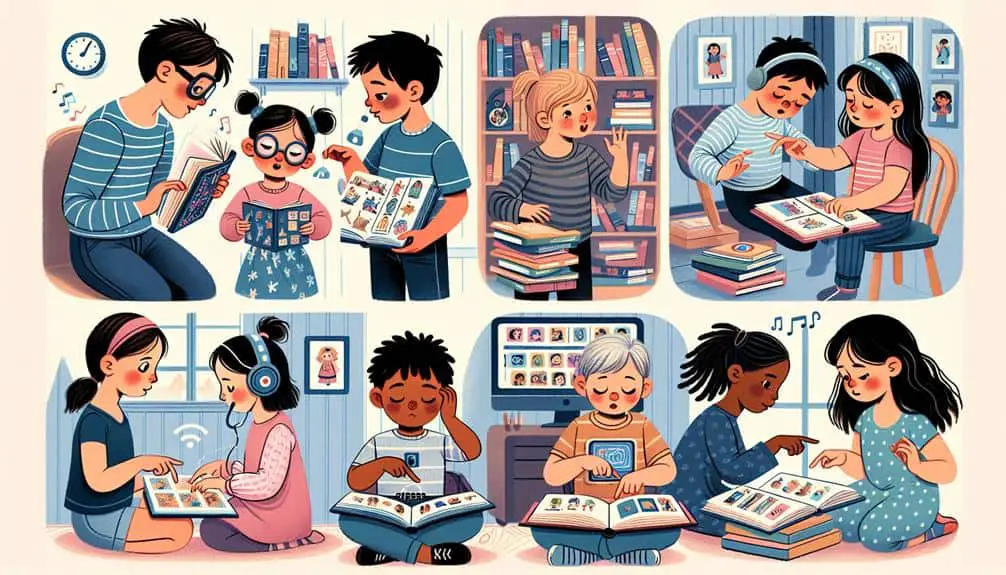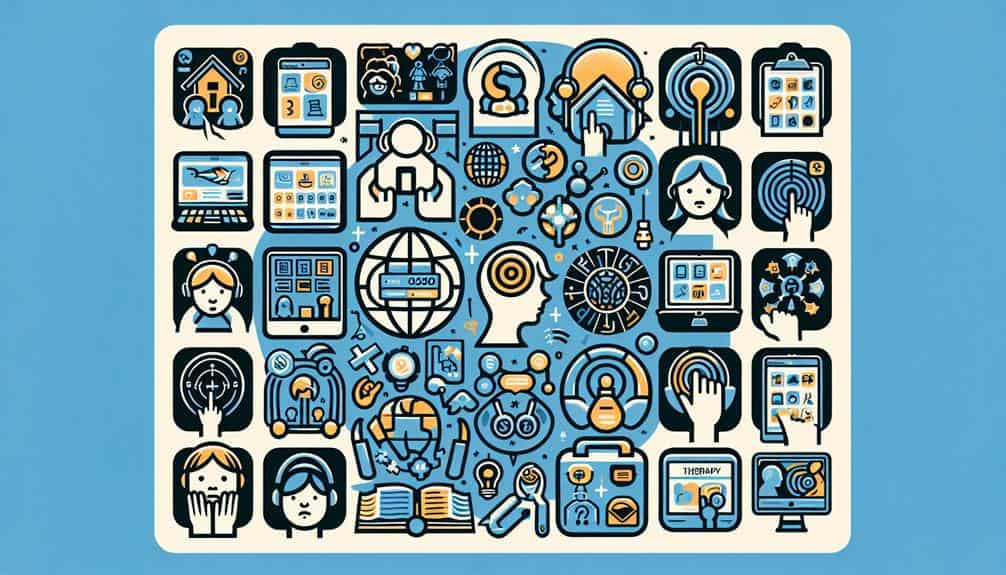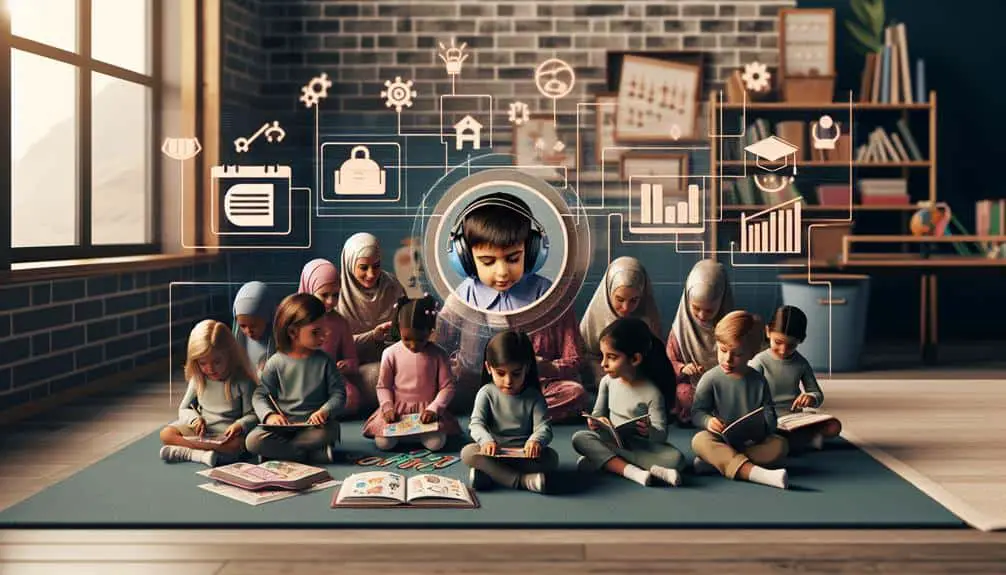Enhance your special needs homeschooling with multisensory reading strategies. Tailor learning to different styles using textured letters, colorful flashcards, and audiobooks. Create individualized plans based on strengths and challenges, adjusting as needed. Utilize technology for interactive comprehension practice and connect with educators for personalized support. Add movement to lessons to boost engagement and comprehension. Build confidence with fun games, visual aids, and a supportive environment. By exploring these methods, you can provide a well-rounded approach to nurturing your child's literacy skills.
Key Points
- Utilize multisensory approaches tailored to different learning styles.
- Develop individualized reading plans based on unique strengths and challenges.
- Incorporate technology tools for personalized reading support and engagement.
- Integrate movement into lessons to enhance comprehension and retention.
- Cultivate reading confidence and fluency through interactive and enjoyable activities.
Multisensory Approaches for Reading
If you're looking to enhance your special needs homeschooling reading curriculum, consider incorporating multisensory approaches to cater to different learning styles. Utilizing tactile techniques such as textured letters or sandpaper alphabet cards can help tactile learners better grasp reading concepts by engaging their sense of touch.
Visual aids like colorful flashcards or graphic organizers can assist visual learners in understanding and retaining information more effectively.
For auditory activities, reading aloud together or using audiobooks can benefit auditory learners by allowing them to process information through listening.
Kinesthetic exercises like acting out stories or using manipulatives during reading sessions can engage kinesthetic learners and make the reading experience more interactive and memorable.
Individualized Reading Plans
Think about creating personalized reading plans tailored to your child's unique learning needs and abilities to optimize their reading progress and enjoyment. Developing individualized reading plans can make a significant difference in your child's learning journey.
Here are some key strategies to contemplate:
- Setting personalized goals: Tailor reading objectives to your child's specific strengths and challenges. These goals should be achievable yet challenging enough to encourage growth.
- Implementing progress tracking: Regularly monitor your child's reading advancement and adjust the plan accordingly. Tracking progress allows you to celebrate successes and identify areas that may need extra attention.
- Utilizing adaptive resources and accommodations: Incorporate tools and strategies that cater to your child's learning style. This could include audiobooks, visual aids, or modified reading materials to enhance comprehension and engagement.
Technology Tools for Reading Support
Now, let's explore how technology tools can provide valuable support for enhancing your child's reading skills and overall learning experience.
Interactive apps and digital resources offer engaging ways to practice reading comprehension, phonics, and vocabulary. These tools can adapt to your child's pace and provide immediate feedback, fostering a sense of accomplishment.
Virtual tutoring and online programs connect your child with experienced educators who can tailor lessons to meet their unique needs. These platforms offer personalized instruction, helping your child build confidence and develop essential reading skills.
Incorporating Movement Into Reading Lessons
Enhancing your child's reading experience can be achieved by incorporating movement into your lessons, igniting their engagement and reinforcing comprehension skills through physical activity. Kinesthetic learning is a powerful tool that allows your child to absorb information better through movement.
Here are some ways to incorporate movement into your reading lessons:
- Act out the Story: Encourage your child to physically act out scenes from the story they're reading, bringing the characters and events to life.
- Sensory Word Movements: Assign specific movements to certain words or phrases in the text, helping your child connect the movement with the meaning of the words.
- Reading Relay Races: Create a fun reading activity where your child reads a passage, then performs a physical task before passing the baton to the next reader.
Building Reading Confidence and Fluency
To help your child build reading confidence and fluency, it's important to create a supportive learning environment that nurtures their growth and development in literacy skills.
Reading games and interactive exercises can make the learning process engaging and enjoyable. These activities can help your child practice reading in a fun way, boosting their confidence as they see improvements over time.
Visual aids, such as colorful flashcards or illustrations, can also enhance comprehension and retention of information.
Additionally, having a reading buddy, whether it's a sibling, parent, or even a stuffed animal, can provide a sense of comfort and encouragement during reading sessions.
Encouraging your child to read aloud and at their own pace can help improve fluency. Celebrate their progress, no matter how small, to motivate them to keep pushing forward.
Remember to be patient and understanding, offering support and positive reinforcement along the way.
Frequently Asked Questions
How Can I Incorporate Sign Language Into Reading Lessons for My Special Needs Child?
To incorporate sign language into reading lessons for your special needs child, start by using visual cues in interactive stories. This multisensory approach enhances learning and communication skills, making reading more engaging and accessible for your child.
Are There Specific Reading Strategies for Children With ADHD and Dyslexia?
When working with ADHD accommodations and dyslexia techniques in reading, remember to provide structured routines, multisensory learning experiences, and frequent breaks. Tailoring instruction to individual needs and incorporating visual aids can enhance comprehension.
What Are Some Innovative Ways to Use Music in Reading Activities?
To enhance reading with music, try using rhythm to aid focus and memory. Interactive songs can engage learners, making reading fun and effective. Incorporating music into reading activities can energize and support comprehension.
Can Reading Games and Puzzles Be Effective for Special Needs Learners?
Engaging reading games and puzzles can be highly effective for special needs learners. Interactive apps offer diverse experiences, while multi-sensory approaches cater to varying learning styles. These tools make learning fun and accessible for all.
How Can I Adapt Reading Materials for Children With Sensory Processing Disorders?
When adapting reading materials for children with sensory processing disorders, consider using visual aids and multisensory techniques. Interactive stories and textured books can engage their senses and enhance comprehension. These tools create a more inclusive learning environment.



